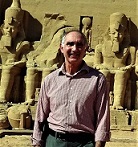


|
|
|
|||||||||||||||
|
|
||||||||||||||||
|
|
|||
|
|
Temples at Abu Simbel
The Temples of Abu Simbel consist of two temples which were originally carved out of the mountainside at the border of Southern Egypt and Nubia by the Pharaoh Ramesses II (the Great) (1279–13 BCE) to proclaim his greatness and commemorate the Battle of Kadesh fought between the Egyptians and the Hittites. It was also designed to proclaim the power and military might of Egypt and was placed there to impress any potential invaders. Like the Temple of Philae, the temples were dismantled and moved to a new location in the 1960s in order to save them from being submerged by the waters of Lake Nasser by the construction of the Aswan High Dam. One of the temples is dedicated to Ramesses and the other to his queen Nefertari. The construction of the complex started around 1264 BCE and took over 20 years to complete. The Great Temple – the temple of Ramesses - was dedicated to the gods Amun, Ra-Horakhty, and Ptah, as well as to the deified Ramesses himself. The facade of the temple is 35 metres (115 feet) wide and consists of four statues of Ramesses - 20 metres 965.5 feet) high, which are carved out of the cliff face: two on either side of the temple entrance.  The statues are also functional, as they support the façade. They show Ramesses II, seated on a throne and wearing the double crown of Upper and Lower Egypt. Around his feet are carvings depicting his wife Queen Nefertari, his mother, Queen Tuya, and some of his many children.  When first constructed, the statues would have been painted and would have been an impressive sight. The upper part of one of the large statues has broken away from the lower section, as the result of an earthquake, but still remains at the foot of the statue. 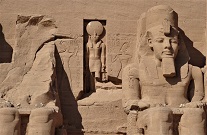 Over the entrance is a bas-relief showing two images of the king worshipping the falcon-headed Ra Harakhti, whose statue is in a niche. At the top of the facade is a row of 22 baboons; their arms raised in the air, supposedly worshipping the rising sun. In front of the facade is a stele that records the marriage of Ramesses with a daughter of King Hattusili III. This marriage sealed the peace between Egypt and the Hittites following the battle of Kaddesh and the subsequent peace treaty. The interior consists of three chambers receding 56 metres (157 feet) into the cliff. 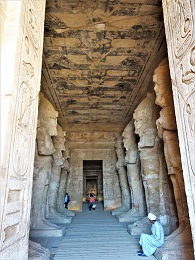 These are decorated with statues of the Ramesses and painted scenes depicting the Battle of Kadesh (1275 BCE); a battle which both the Egyptians and the Hittites claimed as a victory. Photographs are not allowed in the temple, but you are permitted to take them from the entrance. The first chamber is the hypostyle hall which is 18 metres (59 feet) long and 16.7 metres (22 feet) wide. The roof is supported by 8 large pillars depicting Ramesses. Depictions of his military triumphs are shown on the walls. Moving further into the temple is the second chamber; this has four pillars showing scenes of Ramesses making offerings to the Gods and of Ramesses and Nefertari with the sacred boats of Amun and Ra-Harakhti. At the far end is the sanctuary which contains the statues of four seated figures cut out of the rock: the deified Ramesses, and the gods Ra-Horakhty, Amun Ra and Ptah. 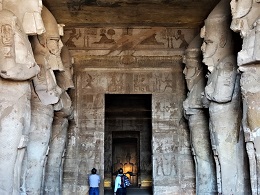 On the 22 February and 22 October the rays of the rising sun penetrate the whole length of the temple and illuminate the statues with the exception of Ptah, the God connected with the Underworld, who always remains in the shadow. The second temple known as the Small Temple was dedicated to Hathor and Nefertari, is 100 metres to the northeast of the Great Temple. 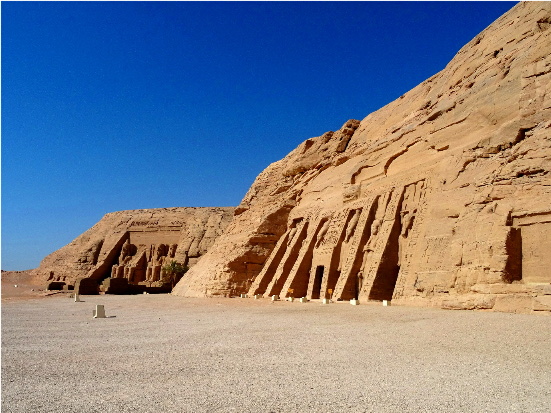 Nefertari was Rameses’ favourite wife and was held in such esteem that he not only constructed a temple for her but also portrayed her as of equal size to himself. Traditionally, the statues of the Queens had never been taller than the Pharaoh’s knees. This temple was also cut from the cliff face, and the façade has two groups of figures of over 10 metres (32 feet) high of Ramesses and Nefertari, on either side of the entrance.  The interior is similar to Ramesses Temple but on a smaller scale. The hypostyle hall is supported by six Hathoric columns (Columns that have the face of Hathor) and are decorated with images of Nefertari, Ramedses and the gods. This then leads to the Sanctuary. 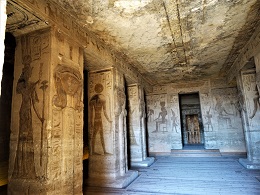 It is known that Ramesdes went to Abu Simbel with Nefertari in the 24th year of his reign but following his death, it ceased to be used, and by the 6th century BCE the main temple was covered by sand up to the knees of the statues of Ramesses. Little is known of the temple until 1813 AD when Jean-Louis Burckhardt discovered it; although it was Giovanni Belzoni who was to remove the sand to allow him to enter the temple in 1817. With the plans to build the Aswan High Dam it became imperative to save the temple from the waters of Lake Nasser which would have flooded the whole complex. A number of schemes were suggested but it was decided to remove the top of the mountain, cut up the temples into blocks weighing up to 30 tons, move it to its new location 65 metres (213 feet) above its original site and 200 metres (656 feet) from the water, construct a concrete dome and then reassemble it. The concrete dome was then covered to give it a natural look. The process took four years and cost $40 million. In 1979 the site was designated the UNESCO World Heritage Site of the Nubian Monuments from Abu Simbel to Philae. To see more photographs and take a virtual tour of the site click on the photoshow below.
|
|
|
|
|
|||
All Photographs were taken by and are copyright of Ron Gatepain
| Site Map |
